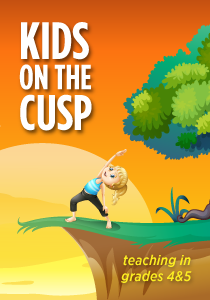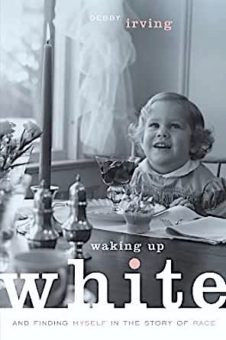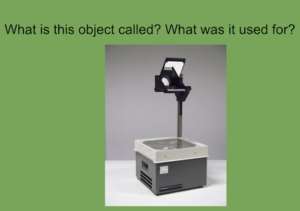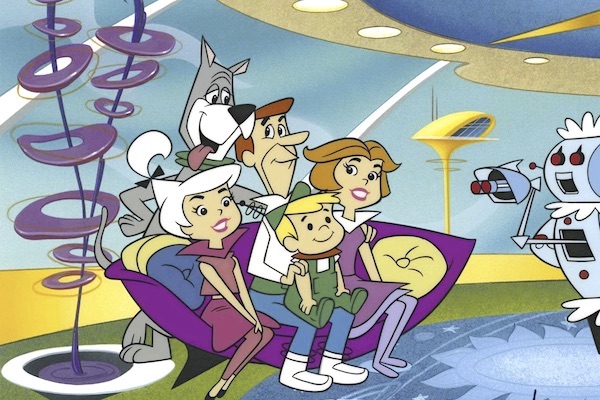Jumping in Each Day and Rolling with the Flow
A MiddleWeb Blog
Finding Our Way as a Culture in a Post-Jetson World

For almost eight months, I have been teaching my students from a laptop in my living room. When you think about it, that particular classroom setting is a bit space-aged in itself.
As a child, I remember sitting cross-legged in front of the television on Saturday mornings, watching The Jetsons, a cartoon launched by Hanna-Barbera in 1962.
In its opening song, we meet George and his futuristic family, as each of his two children are efficiently dropped off at school and Jane (George’s wife) grabs his wallet before slipping out of the family-sized spaceship to go to the mall, where she will presumably spend George’s hard-earned cash.
The title sequence ends with George being dropped off via conveyor belt at his desk. Feet up and hands clasped behind his head, he leans back and prepares to do absolutely nothing.
The Jetsons’ lives were filled with amazing gadgets that peaked my childlike wonder. These possibilities seemed completely and totally impossible to the little girl sitting in awe in front of the television screen, trying to imagine a world she would never live in. The Jetsons could prepare meals in minutes. They had robots to help them maintain their households. They could talk to people on the phone and actually see their faces on a screen!
Time travel to now
Yet, here we are in 2021, and Jetson-like accoutrements surround us. For nearly eight months, I’ve taught an entire class of fourth graders on a screen. I can zoom into multiple breakout rooms where the kids are working in partnerships or in small groups with a click or two on my keyboard. How Jetsons is that?
In an article in The Smithsonian, Matt Novak discusses this classic cartoon and the wonder it evoked, with a look at some individual episodes. “This little show – for better and for worse – has had a profound impact on the way that Americans think and talk about the future,” he writes.
Novak’s glimpse into the world of the Jetsons gives much pause for thought, including the acknowledgement that many of those childhood impossibilities from a half a century ago are now very firm realities.
Devon Maloney also explored the impact of this seemingly innocent cartoon in a 2017 article in The Verge. Maloney discusses the dystopian aspect of the Jetson family’s world, along with some of the more distrurbing subtexts that were being received by young viewers across America – future leaders who were in the process of acquiring and forming their own ideas about life, about how our world works, and about what the next century might look like.
But at age nine, I didn’t notice what Maloney noticed. I didn’t notice that there were no black people in space. I just really wanted to be able to talk to my friends on a video phone.
The students in front of me each day are the same age as that little girl. Their developing minds are forming opinions about the world, both consciously and subconsciously, just like she did. Whether they are learning remotely from home or sitting behind plexiglass shields, what I project to them matters more than I will ever truly know.
Social conscience over the decades
When I began teaching, about a quarter of a century ago, my classroom (Room 4T) looked nothing like the Big Dipper School that Elroy Jetson attended. We had a reading rug, a chalkboard, and an overhead projector (which heated up at the speed of light and burned the side of your hand if you accidentally touched the glass). We used dictionaries and encyclopedias. We loaded VHS tapes into our classroom VCRs. It wasn’t very Jetson.
Back then, we discussed inequality openly in 4T. We read about the injustices of slavery and oppression across time and across cultures. I did my best to talk about the multiple perspectives of historical events and the importance of seeing a story through eyes other than our own.
But it wasn’t until reading Debby Irving’s fearlessly honest prose in Waking Up White, that I learned many uncomfortable truths about the world…and myself. Many of these specific truths can never be discussed with my current student population. They’re nine and ten years old. It’s too complex. But I can continue to give them a look at history through multiple lenses. Irving’s book asked me to look at my own story, my personal narrative of growing up white in Suburbia, where I still live and teach.

But reading Irving’s story turned out to be a powerful and eye-opening look into a historical universe I’d been previously unaware of.
The more things change…
After this first plexiglass week, the plan is to use this link and this link, to review the importance of looking at the past to make sense of the present. Then we’ll use this simple slideshow to look at history….80’s style!…with images of some “vintage” artifacts, examples of the technology we thought was so new-age back then. I’m going to ask my students to guess what each object is and how they think it was used.
The only other solid plan I have is to jump in each day and to try to roll with it when the tech glitches out. It’s only been a week since re-entry. It takes time to acclimate to a new atmosphere. I need to stay in the moment. Even so, I still find myself wondering what the future will look like, just like that ten-year old version of me from so long ago.
And after spending over a quarter of a century in a classroom, it might be time to explore a few other career possibilities…ones I used to think were way too Jetson.
Related Resources
Jetson: The Family of the Future (Interview/Documentary Clip with Bill Hanna and Joe Barbera)
Twelve Far-Out Things You Never Knew About the Jetson

Links to More Information and Artifacts of the 80’s: (for those dedicated educators who weren’t even alive in the 80’s and may not know what some of these artifacts are!)
48 Things We Had in Our Home in the 80s



































